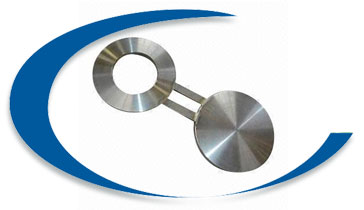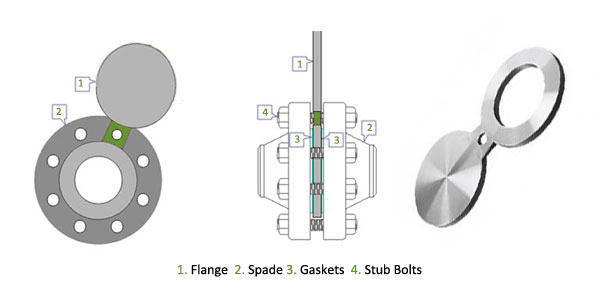Spectacle Blind Flange
What is Spectacle Blind Flange?

Separating one part of a line from another requires a spectacle blind, able to switch from closed to open and back again. Bleed rings provide a means to release pressure from the pipe through a controlled opening. Spectacle flanges are known for their tensile strength, dimensional accuracy and durability. These flanges are made by using best quality material. We offers an extensive range of spectacle flanges in various dimensions and specification.The first and most widely used type are spec blinds – short for spectacle: these are flanges with two equal outside diameter (OD) parts welded together by way of a ‘bridge’.
We are an ISO 9001:2008,ISO 9001-2008, ISO 14001-2004, OHSAS 18001-2007, NSIC-CRISIL, EEPC, and QA-UKAS (ISO 9001-2008), SSI Certified company that follows total Quality Management System. and have been recognized as one of the world’s leading stockists and manufacturer of quality metals for over two decades and are committed to quick responses, unsurpassed quality, competitive pricing, reliable deliveries and an exhaustive inventory.
One of the parts also contains an inside diameter (ID), while the other is a blank, or blind. A whole is put at the halfway mark of the bridge. These are also called spectacles, figure 8’s, and figure 8 blanks, because of their resemblance to reading glasses (spectacles) and figure 8’s. These are referred to as ‘Line Blanks’ in the ASME/ANSI standards.
The second and third types are quite similar: both have longer bridges, referred to as ‘paddles’, which resemble longer handles. One type has only an OD, and so is a blind plate – similar in appearance to a large pizza oven peel. These are referred to as paddle blinds.
The other type is exactly the same but comes with an ID as well, enabling flow-through when installed in a piping system. These pieces have holes in the paddle which enables field personnel to determine by sight which piece is installed in a system. These are referred to as paddle spacers, and are often supplied in sets together with the paddle blinds.
All 3 types of these flanges are used in piping systems or pressure vessels where the flow needs to be interrupted from time to time. They are installed between two pipe flanges (as specified above), and by way of a screw inserted into the hole in the bridge or paddle, they are able to rotate or ‘swing’ into and out of position to interrupt or allow the flow, as the user sees fit. Our spec blind flanges are available with raised, flat, or RTJ faces.
This is a flange plate which as its name implies is shaped like a pair of spectacles only in this case one spectacle is open and the other is blanked off. This plate is installed in the pipeline between a pair of flanges. In normal operation the plate is installed with the open side in the pipeline so it does not restrict the flow. However, once the pressure has been taken off the flange plates can be loosened and the spectacle plate changed to put the blind side in the flow. This will completely seal off the flow making the line safe to work on.
Spectacle Blind Flanges Specification
| Type | Spectacle Blind Flange |
| Standards | ANSI B16.5, ANSI B16.47 Series A & B, MSS SP44, ASA, API-605, AWWA, Custom Drawings |
| Outside Diameter | ≤ 24 = 1.6 mm > 24 = ± 3.2 mm |
| Inside Diameter | ≤ 10 = ± 0.8 mm > 12 = + 1.6 mm / - 0 mm |
| Diameter Contact Face | 1.6 mm RF = ±0.8 mm 6.35 mm RF = ±0.4 mm Tongue & Groove = ±0.4 mm Male-Female = ±0.4 mm |
| Outside Diameter of Hub | ≤12 = + 2.4 mm/ - 1.6 mm ≥ 14 = ± 3.2 mm |
| Diameter of Counterbore | Same as for Inside Diameter |
| Drilling | Bolt Circle = 1.6 mm Bolt Hole Spacing = ±0.8 mm Eccentricity Bolt Circle with Respect to Facing ≤2.1/2 = 0.8 mm max ≥3 = 1.6 mm max |
| Thickness | ≤18 = +3.2 mm / -0 ≥20 = +4.8 mm / -0 |
| Length thru Hub | ≤18 = 3.2 mm / - 0.8 mm ≥20 = + 4.8 mm / - 1.6 mm |
| Pressure Ratings: | Class 150, Class 300, Class 400, Class 600, Class 900, Class1500, Class 2500 | PN6, PN10, PN16, PN25, PN40, PN64 etc. |
| Order | Accept custom order |
| Quality Assurance | All fittings and flanges are subject to strict inspection at each stage of the production process, from starting material purchasing to product dispatch. They are visually examined for conformity to ASTM, ASME, MSS, DIN, EN, and JIS codes and standards. Upon request, official certified Inspection Agencies can be called in to witness the material reports, dimensions and quality conformity of products. |
| Marking & Packing | Products are packaged to ensure that there is no damage during transit. In case of exports, standard export packaging is done in wooden cases. All buttweld fittings are marked with Grade, Lot No, Size, Degree and our trade mark. On special requests we can also, make custom marking on our products.#Protected by End Caps. |
| Value Added Services |
|
| Test Certificates | Manufacturer Test Certificate as per EN 10204 / 3.1B, Raw Materials Certificate, 100% Radiography Test Report, Third Party Inspection Report |

| Carbon Steel Lap Joint Flanges: | ASTM A105/A105N, A350 LF1, LF2 CL1/CL2, LF3 CL1/CL2, A694 F42, F46, F48, F50, F52, F56, F60, F65, F70, A516.60, 65, 70 (Spectacle Blind Flange, Spacer Ring/Spade Flange), Steel RST37.2, C22.8 |
| Stainless Steel Lap Joint Flanges: | ASTM A182 F202, F304/304L/304H, F316/316L, F316H, F316TI, F310, F321, F904L |
| Alloy Steel Lap Joint Flanges: | ASTM A182 F1, F5, F9, F11, F22, F91 |
| Special Alloy Lap Joint Flanges: | Duplex, Super Duplex, Nickel Alloys |
| Flange Face Type: | Weld neck Flate Face (WNFF), Weld neck Raised Face (WNRF), Weld neck Ring Type Joint (WNRTJ) |
| Coating/Surface Treatment: | Anti-rust Paint, Oil Black Paint, Yellow Transparent, Zinc Plated, Cold and Hot Dip Galvanized |
